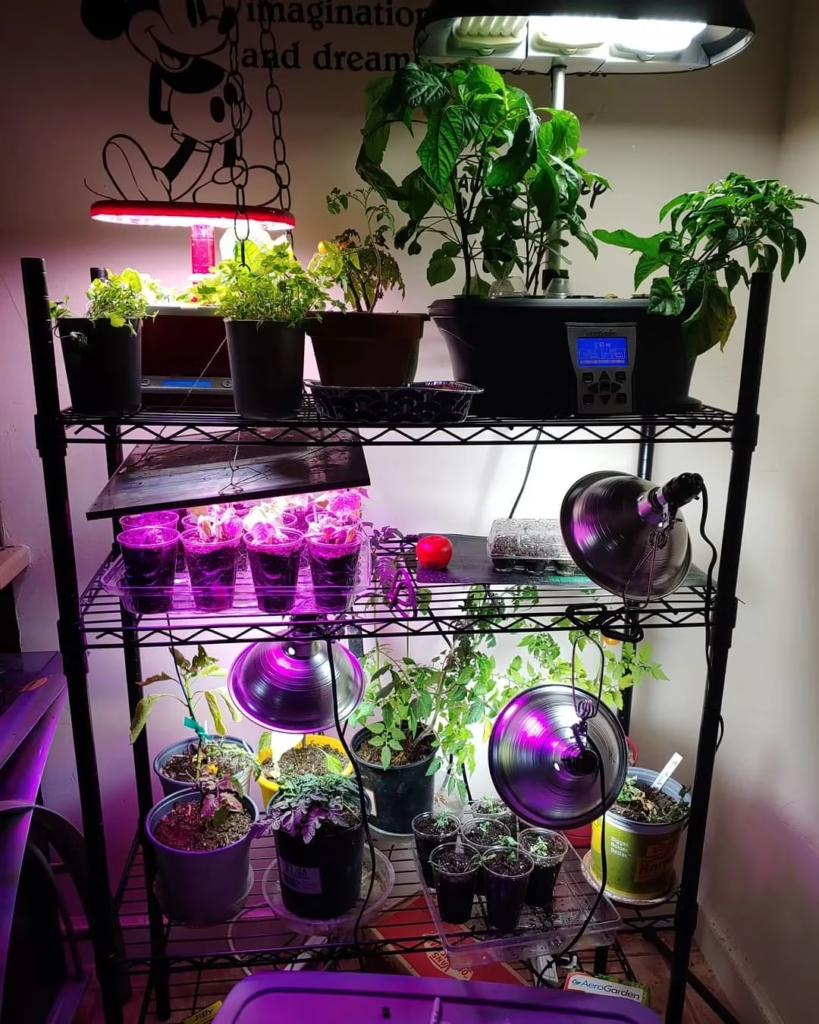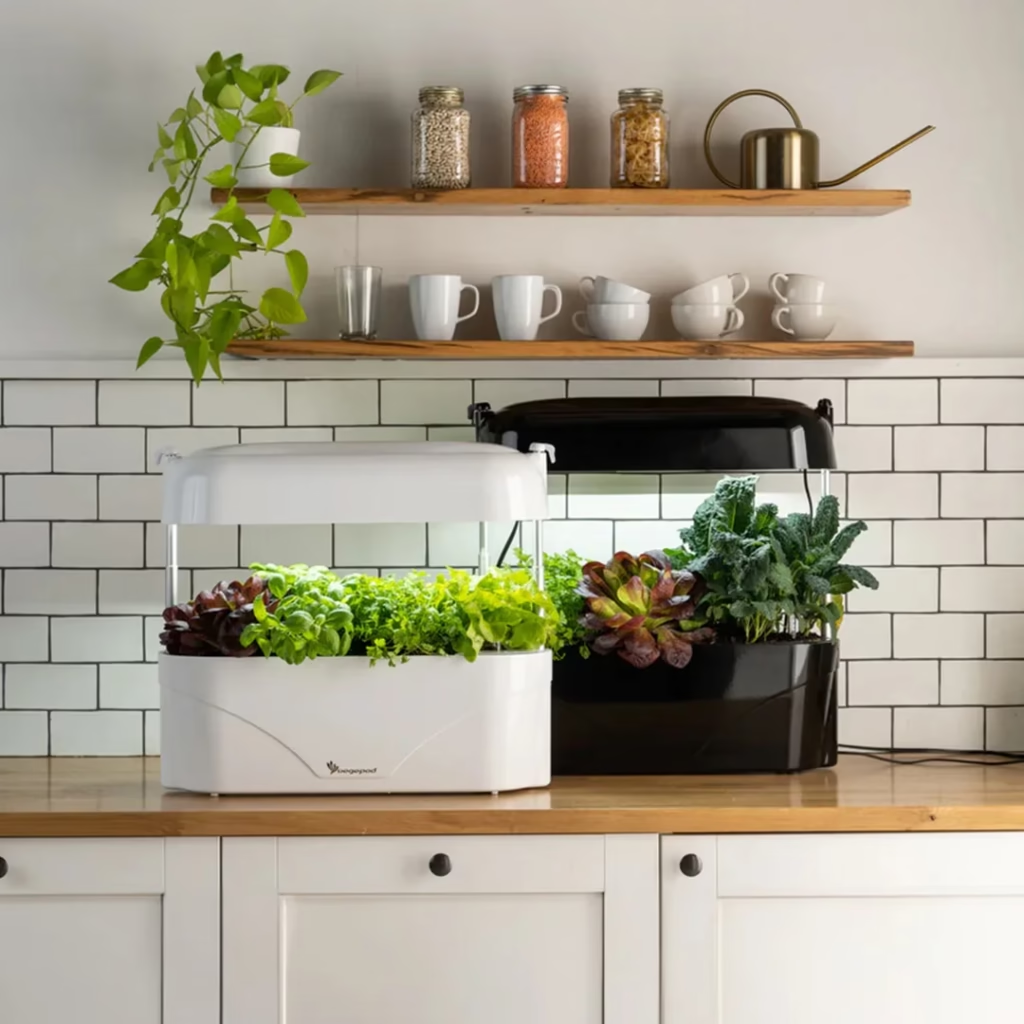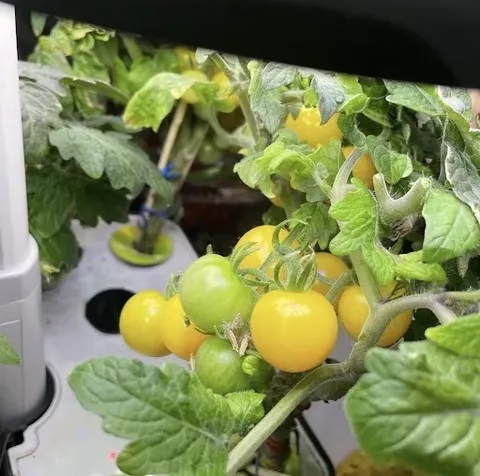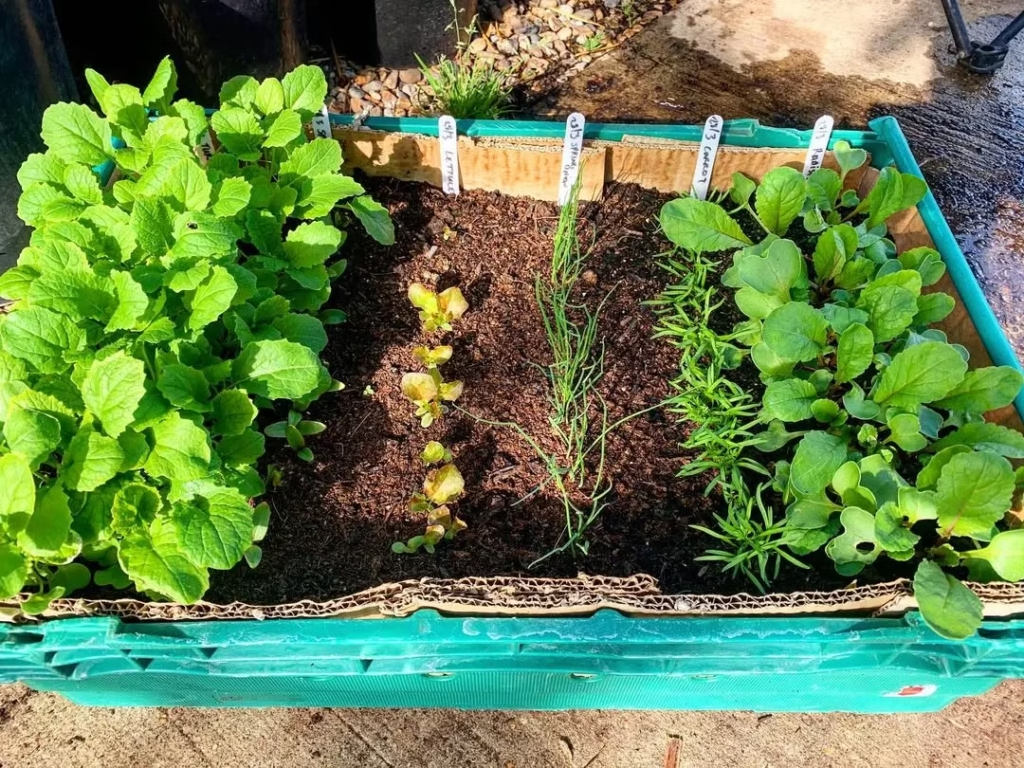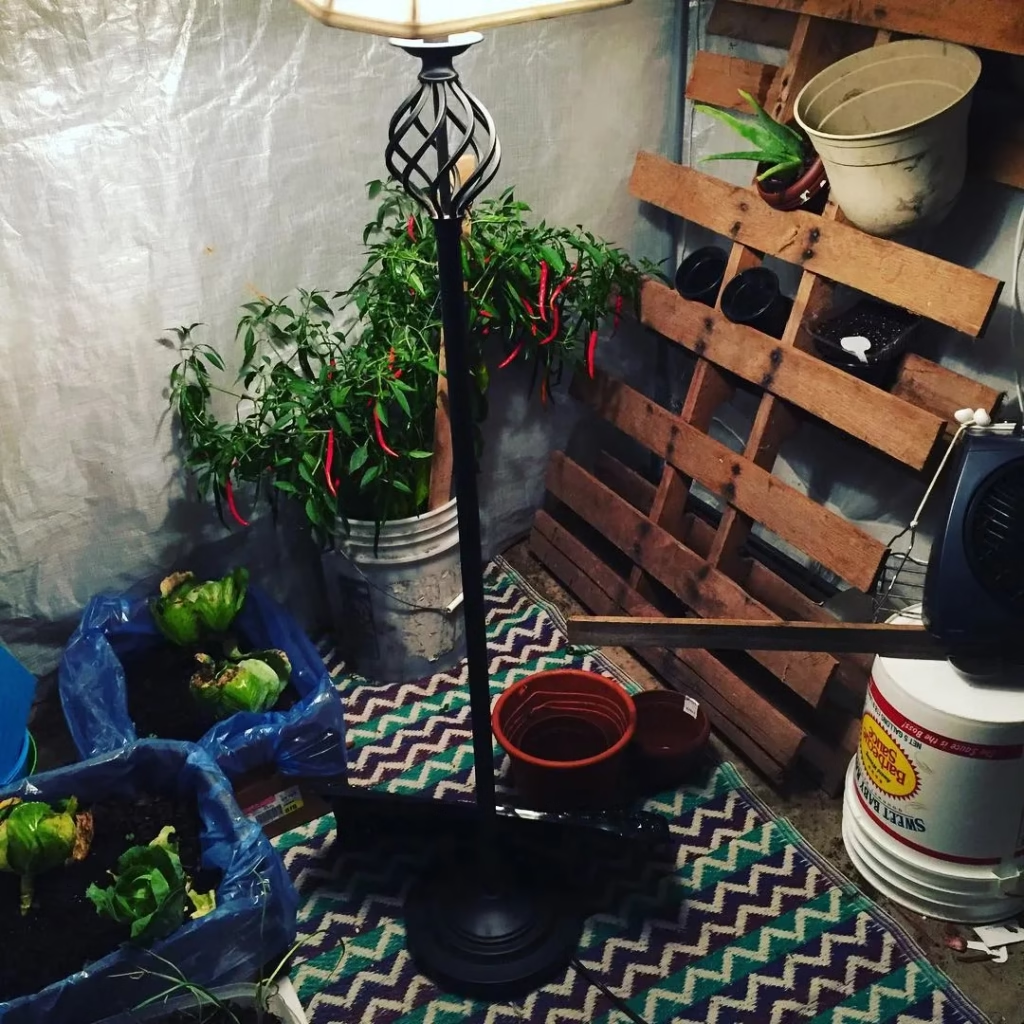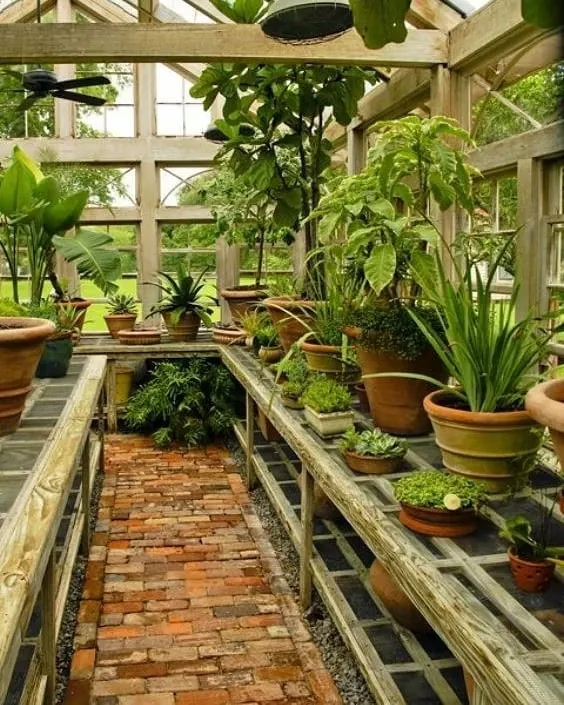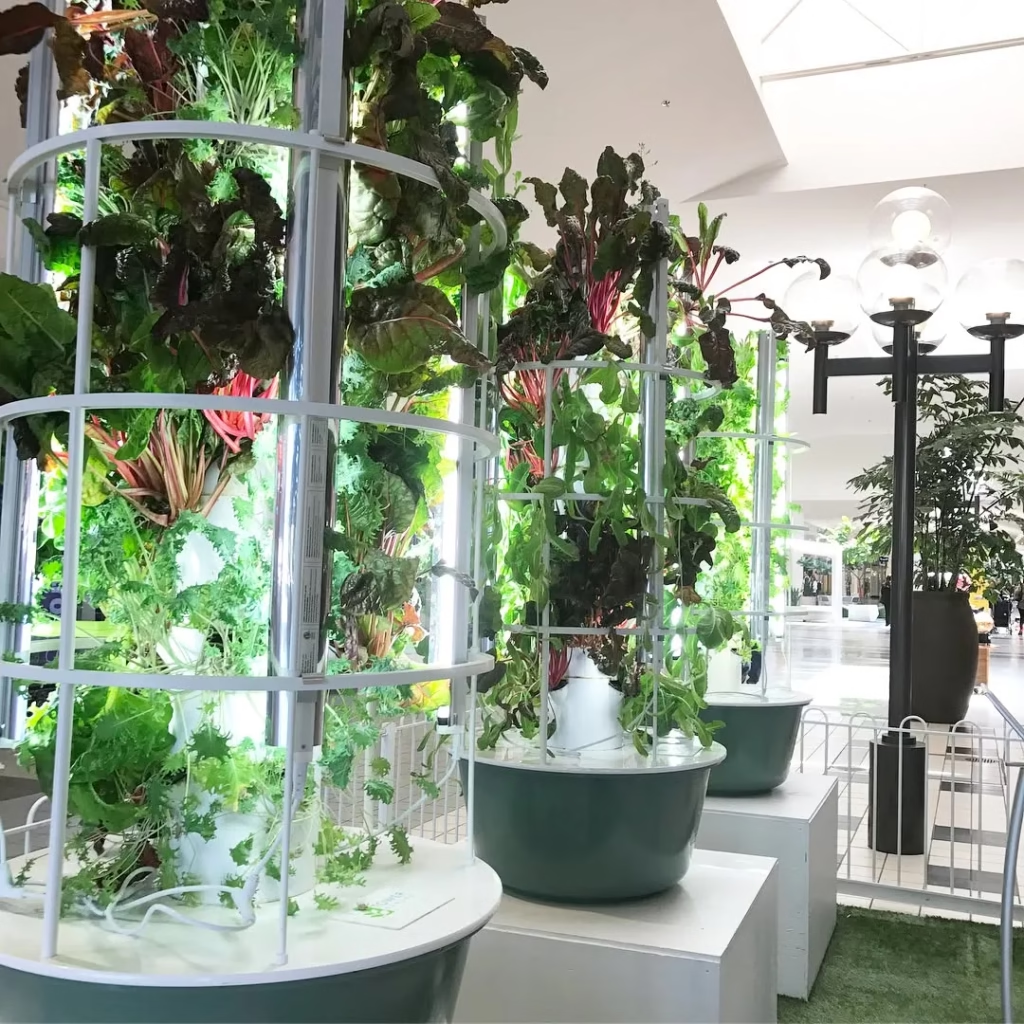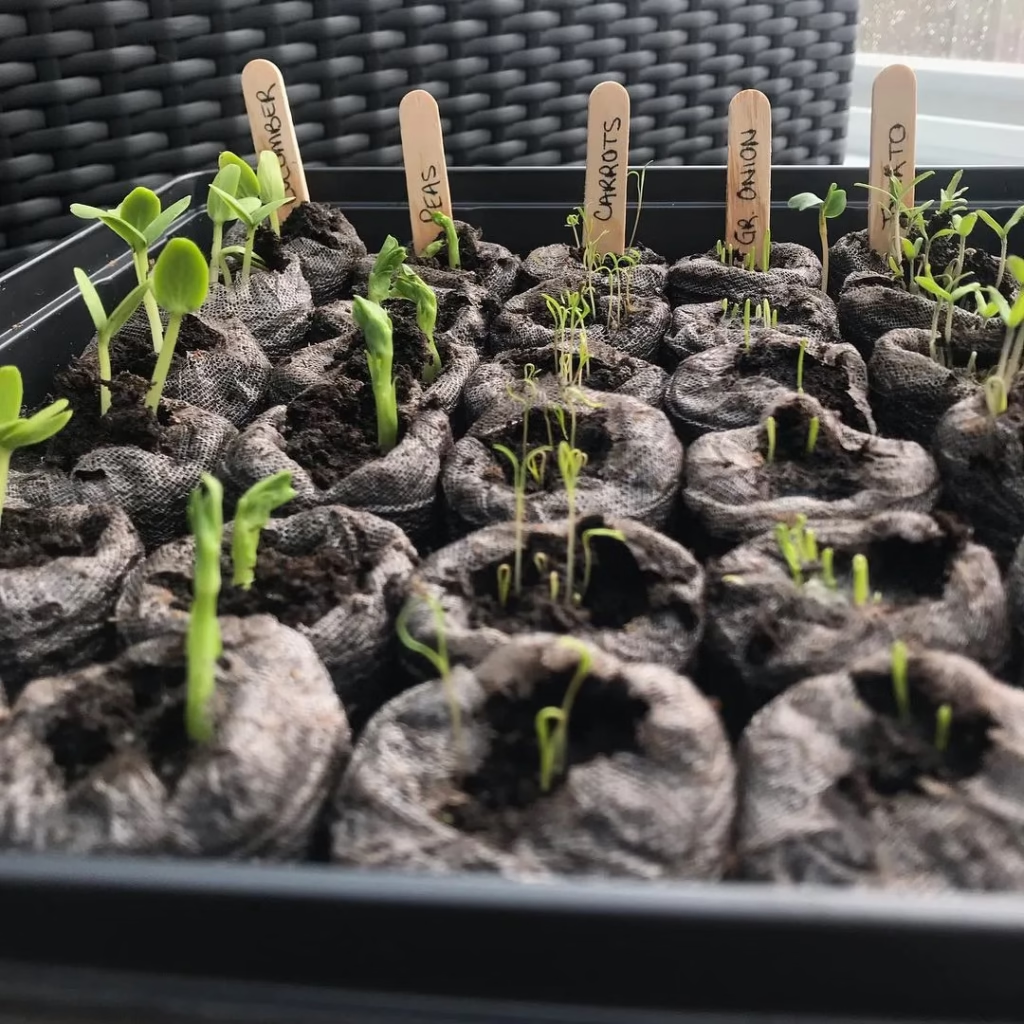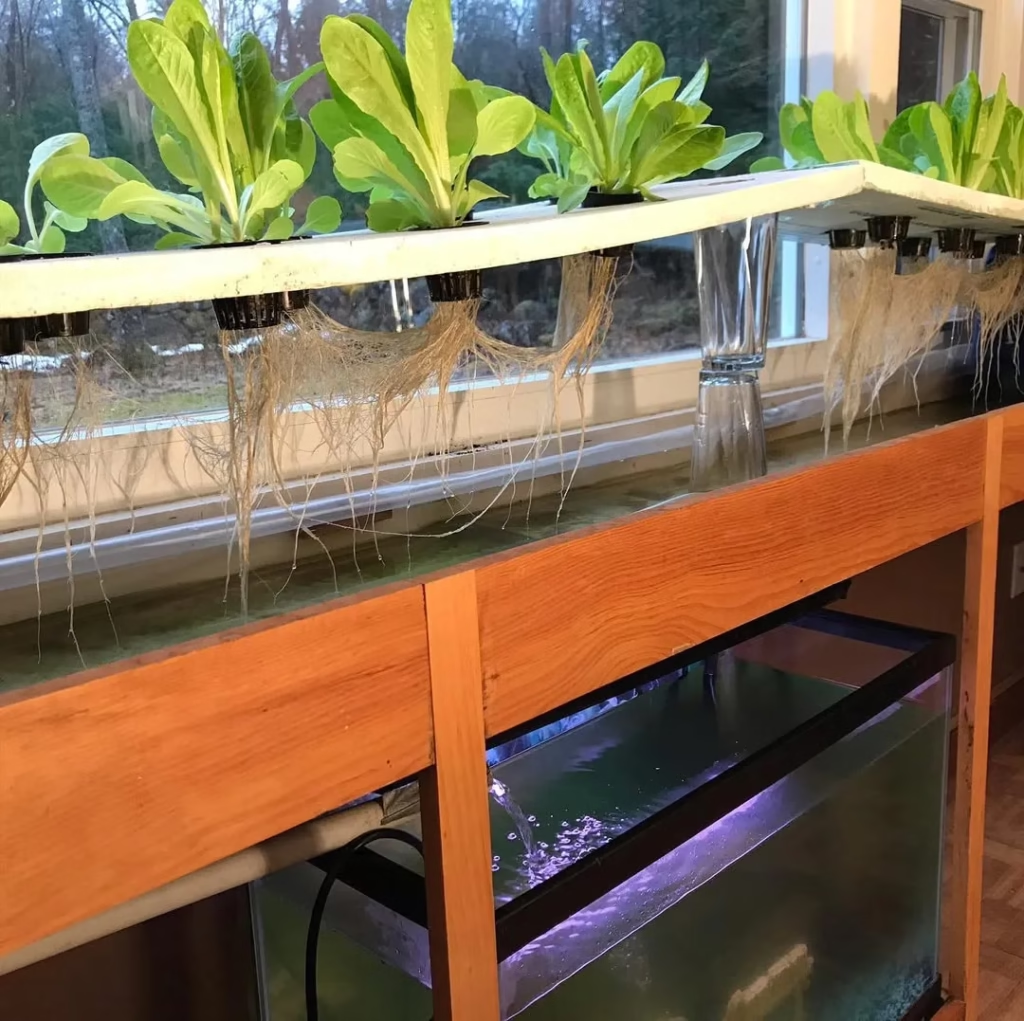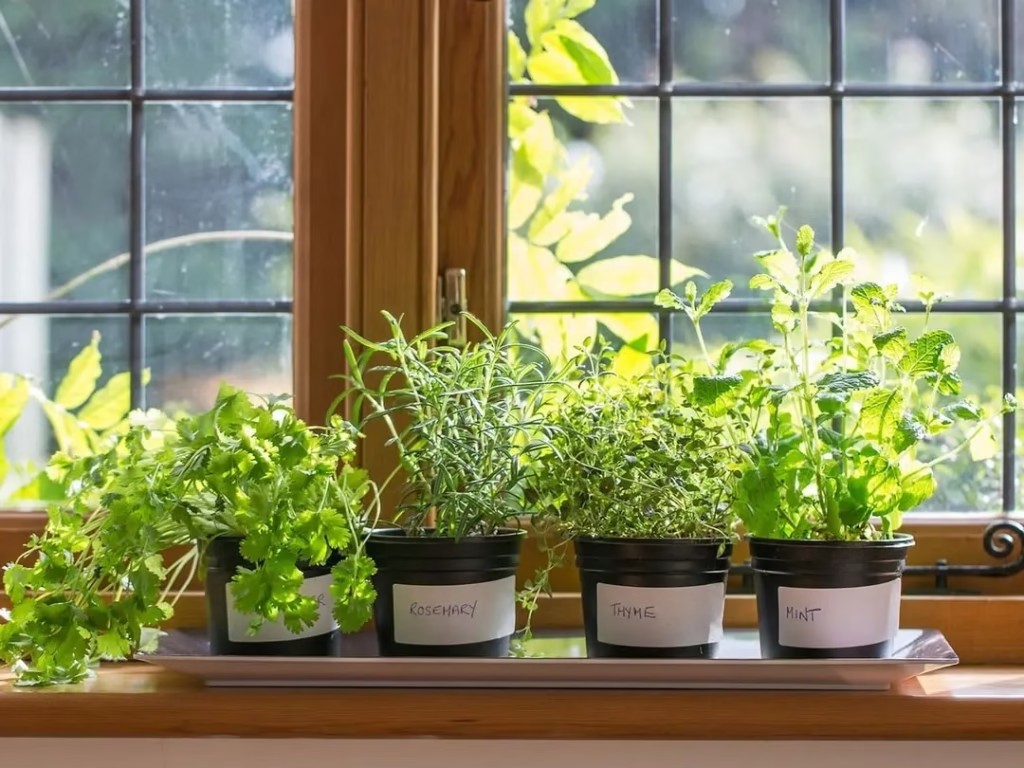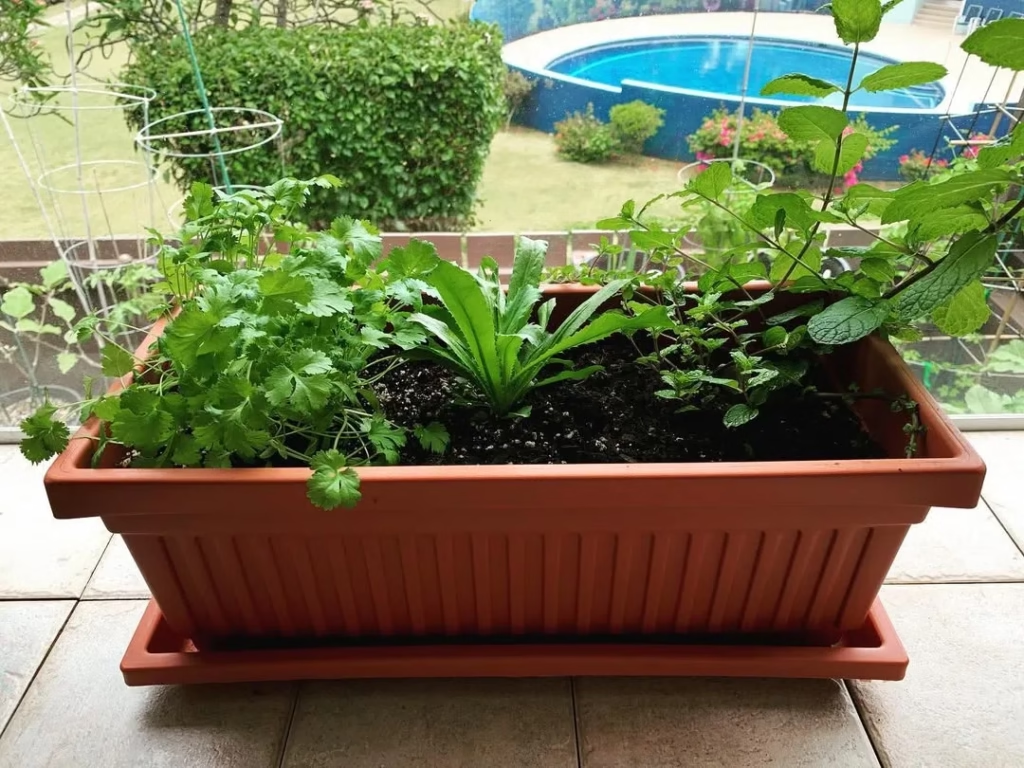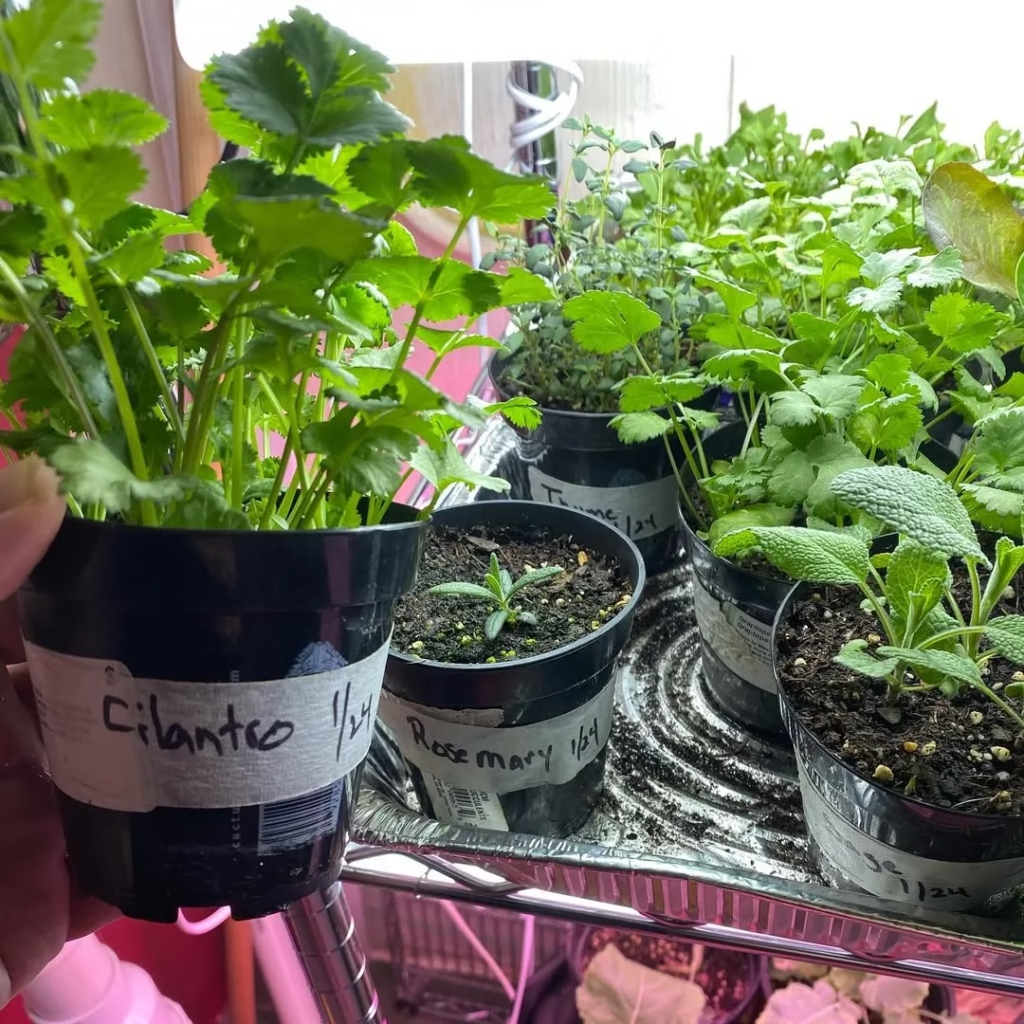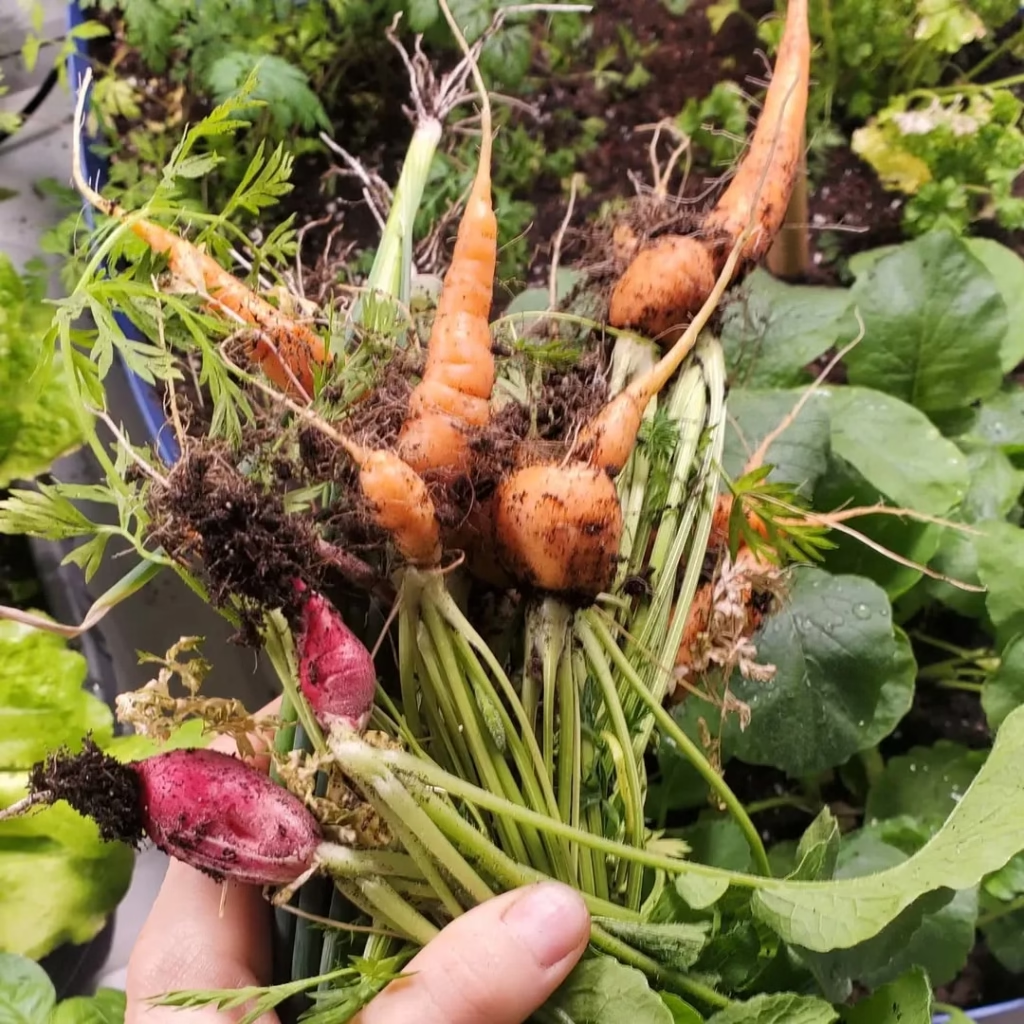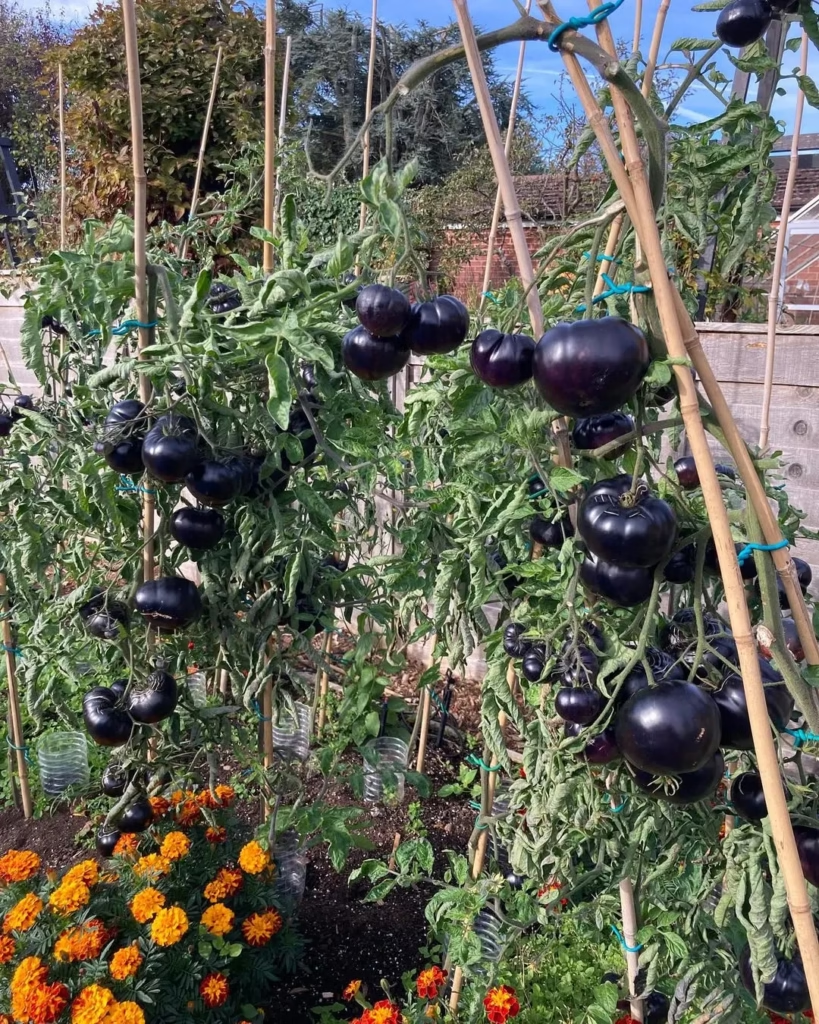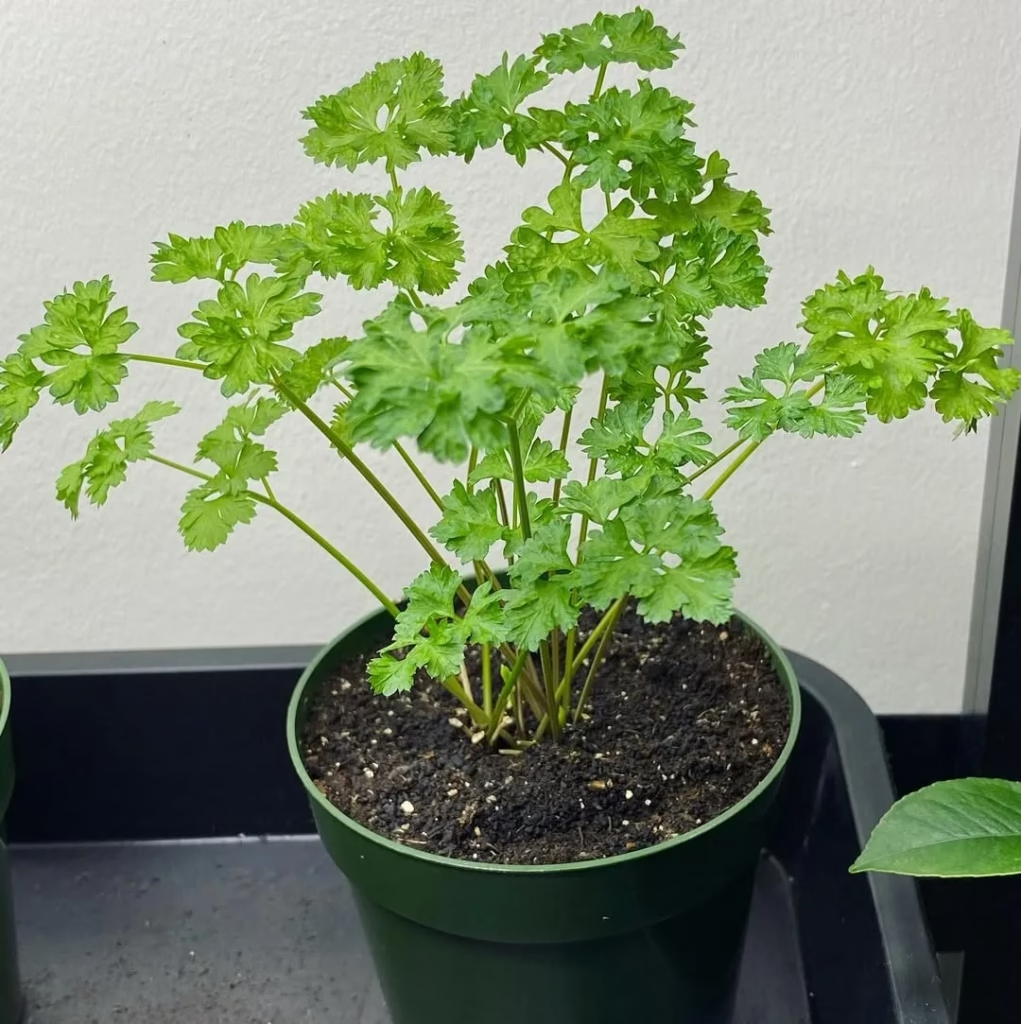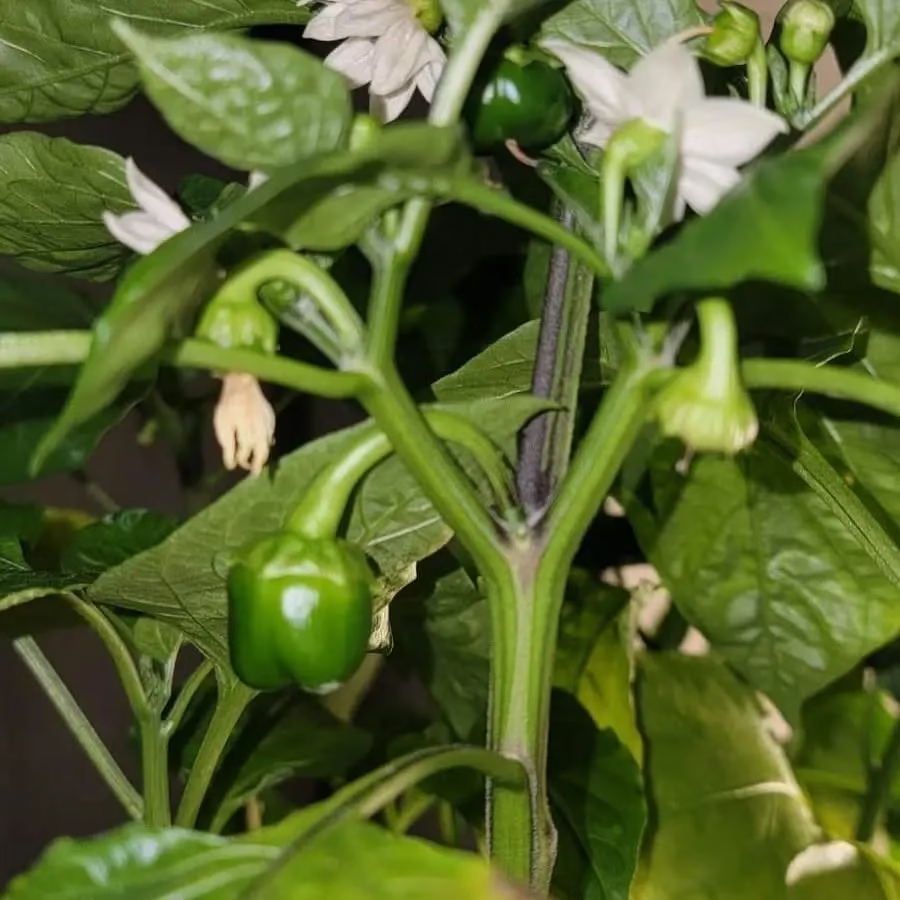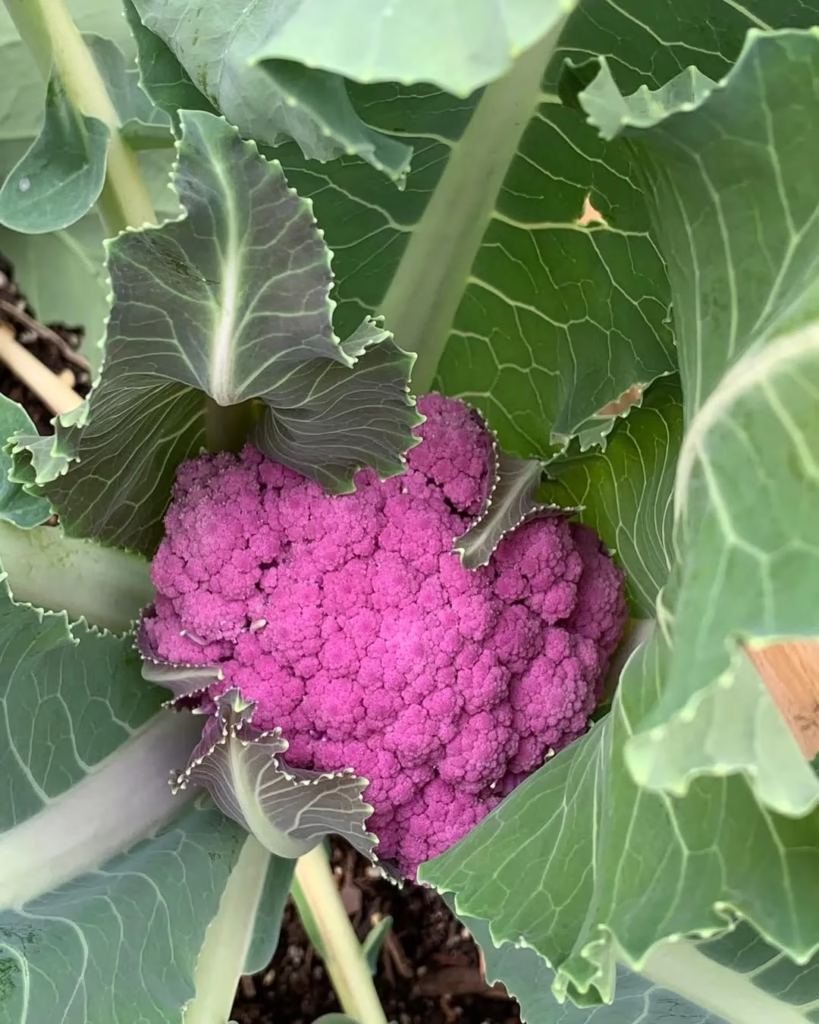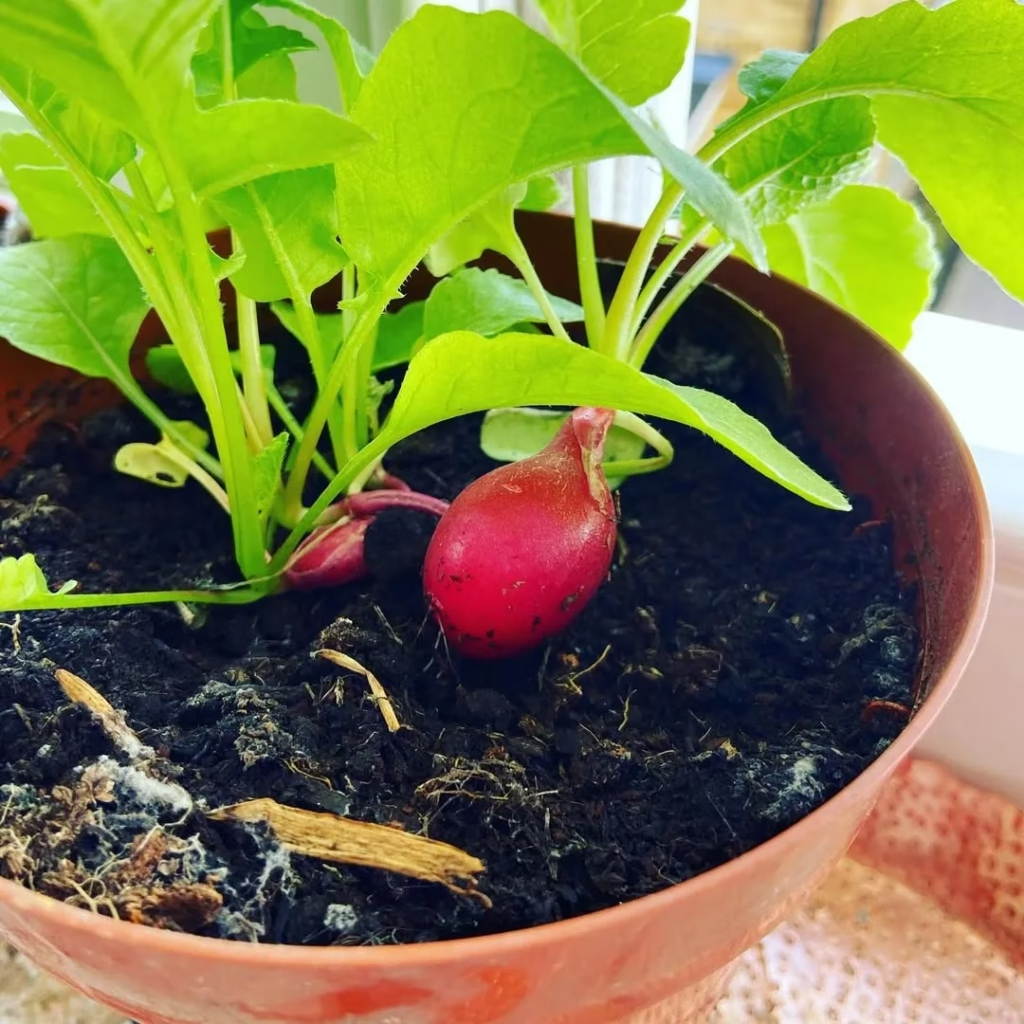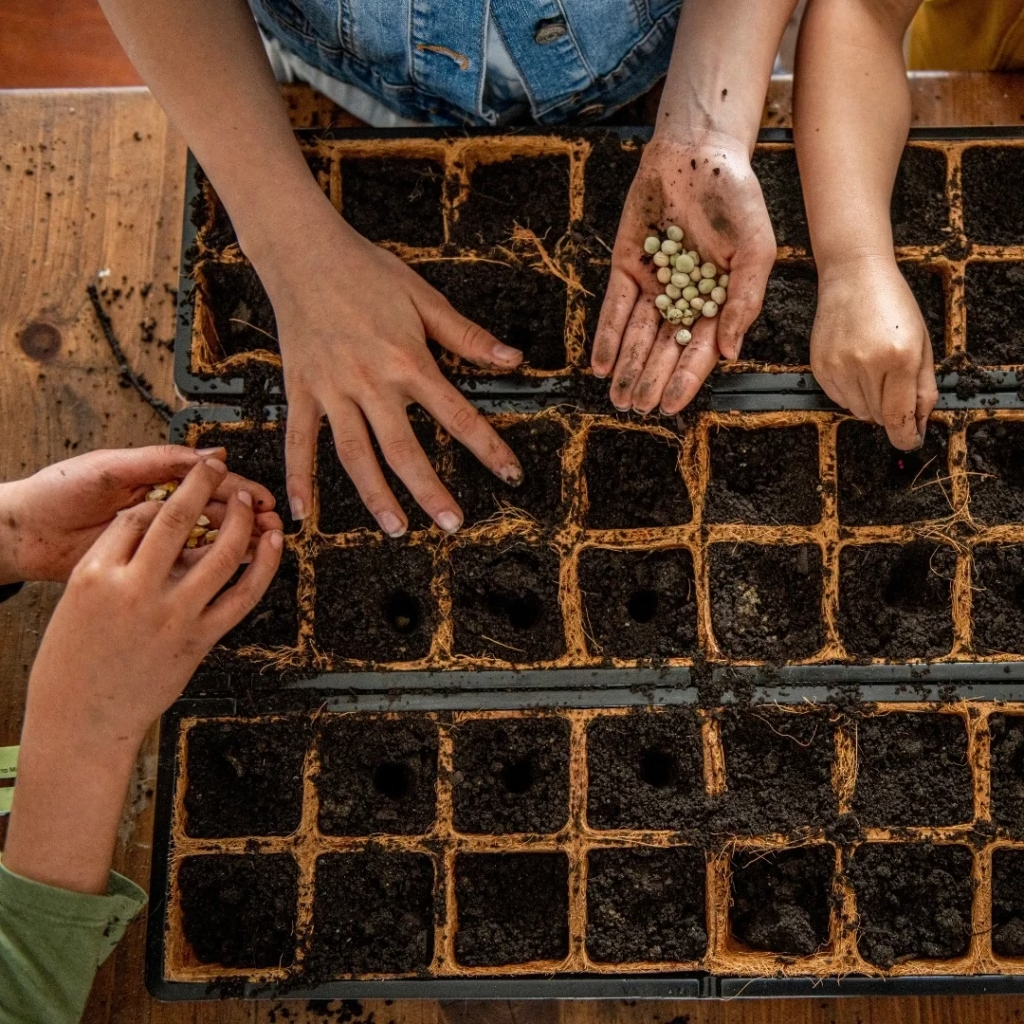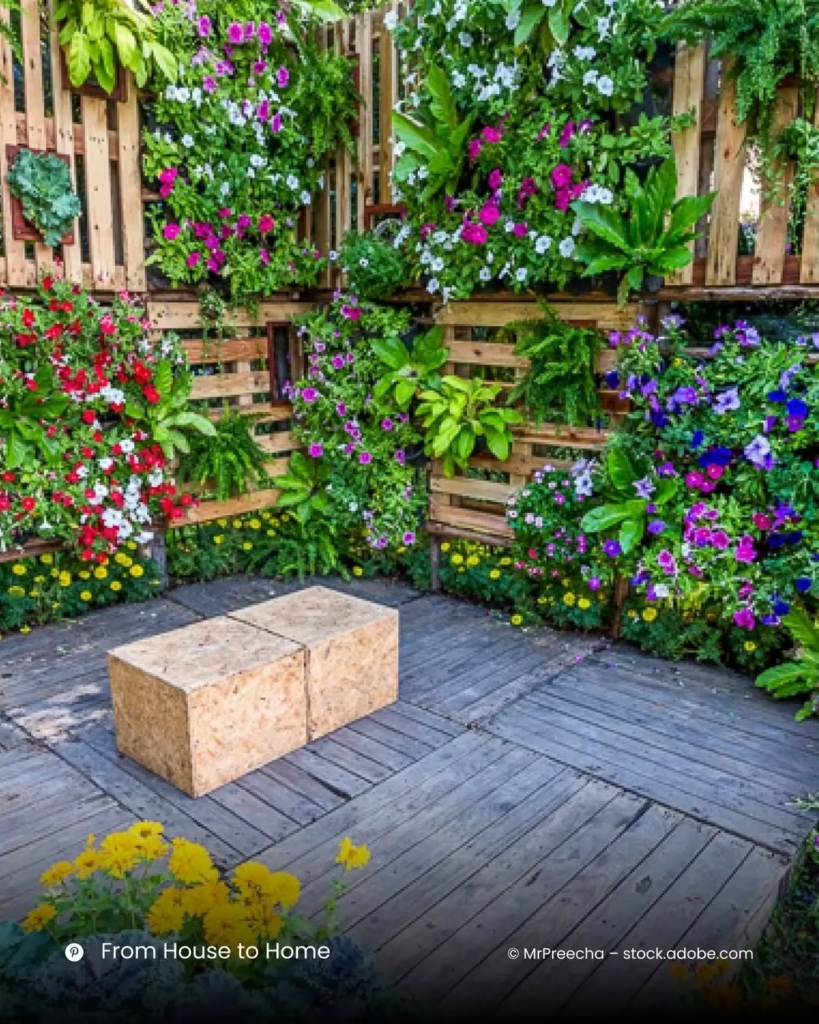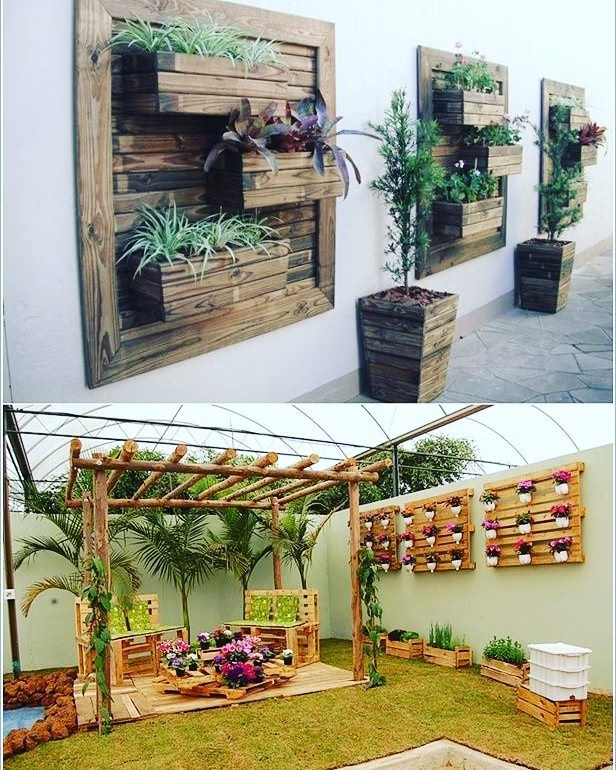What if you had a steady supply of fresh, organic vegetables just steps away from your kitchen no matter the season? With our urban indoor garden solution, this dream can come true. With our small and practical food production system, you can cultivate all sorts of vegetables all year around, for maximum freshness and availability of the product. A product designed for city dwellers and those of us with little space, our indoor garden solution makes the most of vertical growing, so you can grow yourself a bumper crop in the tiniest of apartments. The modular design is also customizable so you can easily find a version that will suit your liking, depending on whether you’d like to grow leafy greens, herbs or perhaps even root vegetables. Our system features high-quality LED grow lights that are integrated with the sun’s full-color spectrum, giving your plants the largest spectrum of color the sun has to offer and allowing your desired plants to thrive. Couple all that with a smart watering solution to make sure your plants always have the perfect level of hydration, and you have an indoor garden that will thrive with little effort from you. Now with our indoor garden system you can taste the flavor of the harvest and enjoy your favorite organic and fresh veggies any time of the year!. [NEW UPGRADE]. Our hydroponic grow kit adds the convenience of growing the perfect garden without the be compelled to run out to your local farmers’ market. With your own food garden, you are lowering your carbon footprint and lowering the impact on the environment created by conventional farming and transportation of produce. With our room-saving indoor garden solution, You can now take charge of your food supply, save money on groceries, and have the pleasure of harvesting your own fresh, organic vegetables all year long. Begin your indoor gardening today and soon you will relish the satisfaction of growing your own food sorely in your house.
parsley and cilantro
Parsley and cilantro rank among the most popular and commonly grown herbs in home gardens and kitchens. While they might resemble each other at first glance, with their bright green, feathered leaves, they provide different flavors and serve different culinary purposes. Parsley has a mild, fresh, slightly peppery flavor, particularly the curly and flat leaf (Italian) varieties. It is frequently used as a garnish or sprinkled into soups, stews, salads and sauces for a burst of brightness. Put cilantro in your food, on the other hand, and you’ve got bold, citrusy flavor that (granted) some people describe as “soapy,” supposedly, because a particular compound in cilantro is detectable only by certain people, but whatever! Cilantro is present in nearly every global cuisine, from Mexican to Indian, Thai to Middle Eastern. Both of these herbs will thrive in a container (or garden bed) with well-drained soil and at least 4-6 hours of sunlight per day. They do well in cool seasons, so spring and fall are good times to plant in many areas. Frequent picking promotes bushier growth and slows down flowering that can cause the flavor to suffer. In the garden, both herbs will bring in the good bugs and serve as companion plants to vegetables such as tomatoes and carrots. Nutritionally, parsley is high in vitamins K and C as well as antioxidants and cilantro is a great source of vitamins A and K and has detoxifying properties.If you are adding a pop of plate color or layering up complex flavor, parsley and cilantro are capable and easy herbs that add glow and health to your meals. 10 Garden on a Pallet
Home Grown Veggies
Home-grown veg is a healthy, sustainable and satisfying way to eat fresh food straight from your garden, balcony or windowsill. By growing your own vegetables you have access to fresh organic produce and it means that you don’t have to rely on the supermarket for your vegies. And if you preserve it, you won’t be consuming any added chemicals. It also tastes great, especially when it’s fresh from your own garden. You can be sure that when you pick the fruit or veg put it in water and serve it up to your family or guests it is freshly picked, contains no preservatives or pesticides. environmentally friendly – growing your own vegetables cuts down on the pollution that would be created and the amount of packaging used to transport fresh produce across the country. Most popular home-grown veggies are tomatoes, cucumbers, carrots, peppers, lettuce, spinach and herbs such as basil and parsley. Beginning a vegetable garden will take some time — choosing the ideal site with the best sunlight, amending soil or pots with nutrient-rich organic matter that has proper drainage, and choosing the right seeds or starts for your local environment. It is possible to grow food even in very small urban spaces with raised beds, pots and vertical gardens. Watering, mulching and organic composting add to the health and growth of the plants and indicate higher yields for this season. It also promotes biological pest control and rotation of crops even for use of inorganic chemicals for fertilizers and pesticides. In addition to the nutritional value, growing your own vegetables also helps to create a deeper connection with food, as well as support mental health. The process of seeds growing and transforming into something that is ready to be harvested can be very rewarding and educational for both children and adults. It teaches patience, responsibility, and respect for the celebration of nature. Home-grown vegetables also taste better than those store bought and can be more nutrient-rich —the store-bought kind may have lost some of its oomph while being shipped and stored. Whether you’re growing a potted herb collection on an apartment windowsill, or a backyard full of home-grown veggies, freshness and flavor that comes from your own garden adds flavor and satisfaction to everyday meals. 10 Pallet Perfection: Garden Wall Ideas
Tomato Veggie Garden
A tomato veggie patch looks great and is an exciting feature for any garden or community garden. Tomatoes are not just one of the most widely grown vegetables around the world, they’re incredibly flexible in the kitchen—with potential uses in salads, sauces and straight up fresh eating. When you’re contemplating starting a tomato garden, the first step is choosing the cultivars that will grow well in your climate and kitchen. Determinate varieties are more compact and ripen up all at once, which makes them ideal for canning, while indeterminate varieties grow into large plants and produce fruit consistently throughout the season. Soil preparation is important, as tomatoes grow best in well-draining, nutritious soil that contains lots of organic matter. A sunny position with 6-8 hours of direct sunlight a day is best for encouraging the most productive flowering. Regular water is a must, especially during dry periods, but water at the base to avoid the development of diseases such as blight. Muching around the plants will hold moisture and cut down on weeds. By staking or caging tomato plants and keeping them off the ground and upright, air can circulate around them more, making them less susceptible to fungal problems. Planting herbs, like basil, or flowers, like marigolds, nearby can help to deter pests and attract pollinators. SUCKER PRUNING And INTERNODE REMOVAL Throughout the growing season it is helpful to trim suckers and monitor for pests and nutrient deficiencies. The garden comes alive with ripe red (or yellow, orange, or purple) tomatoes to pick as summer soldiers on. A tomato veggie garden supplies not just delightful, fresh produce but joy, learning, and rootedness in nature.
Growing Vegetables
Weed without wasting waterImage sourceAlthough the process is quite tough and challenging, but the results are also very rewarding and satisfying; the pleasure that you get when you receive your first crop; the fresh, healthy, delicious ones which you can just take a step forward and pick them right in front of your doorstep makes it worth it. Whether you have a spacious backyard or a tiny balcony, there is no shortage of ways to get you growing vegetables. The first step in starting a vegetable garden is Plan A: choosing which vegetables to grow. Tomatoes, lettuce, carrots, cucumbers, and peppers are popular ones for those new to gardening. These veggies are easy enough for anyone to grow, regardless of where they live. Once you have decided on your vegetables, make certain your soil has plenty of nutrients and good drainage. Raised beds, containers or traditional in-ground gardens all potentially work well, depending on available space. Vegetables generally require a minimum of 6-8 hours of sunlight a day, so a sunny location is the key to success. Consistent watering is important, but be cautious to avoid overwatering, which causes root rot. 2) Mulching -Mucuna is great for mulching around plants – it helps retain moisture and makes it easier to control weeds. Once your veggies start growing, be diligent about checking for pests and disease and use organic options — neem oil, or companion planting — to keep them at bay. Vegetables take time to grow, but oh the bounty: Fresh, flavorful produce for every meal, a feeling of accomplishment and a deeper connection to nature. Whether you’ve been a gardener for decades or you’re new to growing vegetables, nothing beats the feeling of harvesting from your own backyard.
Chilli vegetables
Chili vegetables – a mix of contrasting flavor and texture – are one of the most loved items in Asian style menu. With the hotness of chili and the natural sweetness and crunch of fresh vegetables, this is a little bit of heat and flavor that everyone can appreciate. This dish is a delicacy that could be enjoyed by the spice lovers and the health lovers at the same time.Chilli vegetables are generally a mix of colourful peppers, carrots and vegetables that lend colour, crunch as well as taste to this recipe – they are stir fried to a crisp perfection and contribute in maintaining a bright red lustre for the chilli vegetables. The vegetables are dressed in a sauce with a tang thanks to soy sauce, vinegar, garlic, and ginger and a good dose of red chili. Some take the heat all the way with tomato ketchup or chilli paste to deepen and sweeten.Vegetable chilli is noteworthy for how versatile it is. You can serve this as an appetizer on its own served as a side dish or even in steamed rice or noodles for a complete meal. Not to mention, it’s diet friendly, as it can be made fully vegan or with added proteins such as tofu or paneer for more toothsome texture.But more than imparting flavor, this singular dish ushers in the sheer joy of hastened cooking, a dish where simple spices let the ingredients shine on their own. Great for a party or a quick weeknight meal, this dish is an example of how the most basic ingredients can combine to produce an indisputable classic, when a specific set of spices and techniques are used. Pallet Garden Wall Ideas: 10 DIY Projects to Try
Potatoes Veggie Garden
Read here: How to grow potatoes 16 Veggie garden with potatoes Having a space for potatoes in the veggie garden demonstrates how productive and useful this humble tuber can be. Potato, an important crop cultivated globally, is a one of easy-to-grow crops with a good yield and hence, is appreciated by gardeners. Their ability to grow in a variety of climates and soil types guarantees pretty much anyone can have these nutritional powerhouses in the ground — more potato patches for backyards!Potatoes are grown from seed tubers cut into pieces with at least one eye in each piece. They are sown in well-drained, fertile soil, where they will do well with very little care. The potatoes themselves grow under the ground and produce tubers along the roots; the rest of the plant forms that lush green that ‘pops’ in the garden. Gardeners can try different varieties like russet, Yukon gold, red or fingerling, all with different flavors and textures.Potatoes aren’t just prolific; they’re nutritious. Carb- and fiber-rich, filled with vitamins and minerals including potassium, they serve as the foundation of so many dishes across cuisines. Whether it be crispy fries, creamy mashed potatoes, comforting soups or casseroles, they are both so versatile as a cooking ingredient.In a veggie garden, potatoes work well as companion plants, as their growth habits and soil-clearing capabilities help other crops. And besides, digging potatoes is really much fun, something like a buried treasure hunt. This new trend, which has gardeners growing potato plants in traditional plots, raised beds, or even containers, is a practical, sustainable, and delicious venture perfect for anyone who has a small plot of land or for a host of other growing conditions.
Grow Vegetable Garden
A vegetable garden is a productive and attractive proposition – planting flowers and herbs will also make it look good, as well as boost your fresh produce supply! Whether you have a large yard or a tiny deck, growing food gives you a sense of reconnecting with the land—of reaching across the seemingly indestructible walls of cities and houses, of plucking a ripe fruit or vegetable straight from the plant. A food garden can be customized to your individual tastes, supplying a smorgasbord of crops like tomatoes, cucumbers, lettuce, carrots and peppers for year-round seasonal abundance.Beginning a vegetable garden entails choosing a sunny location with well-draining soil and designing a layout according to the variety of vegetables chosen. They have very shallow roots and by creating space in the top 10cm of the soil the soil improves and you are are also helping to feed the plant with that composting material. Beginners could jump in with easy-to-grow vegetables such as radishes, spinach or green beans, while veteran gardeners might dive into heirloom varieties or exotic crops.But apart from the practical benefits, a vegetable garden also cultivates a greater respect for the environment. What they end up doing is reducing the dependence of store-bought produce, which is much less packaging waste and has a lower carbon impact due to lack of transportation. It’s also an advocate for sustainable environmental practices like composting cooking scraps, preserving water through drip irrigation, and not using harmful pesticides.It’s one of the main benefits of growing a vegetable garden beyond the plate. Taking care of plants is therapeutic, as it gives one a feeling of satisfaction and peace. With all that’s going on in the world these days, seeing such small seeds grow into lush plants is an awesome reminder of the amazing things nature can do. In the end, a vegetable garden provides both physical sustenance and life-sustaining values, and that’s immeasurable to any home.
Summer Vegetable Garden
A summer vegetable garden is a lively and productive place – full of life and color – displaying the finest of the warm-season crops. There are a variety of vegetables that are best planted during the summer months because they prefer the sunny days and warmer conditions – the result is a delicious and flavorful harvest, ideal for seasonal recipes. With a little forethought and some maintenance, a summer garden can become not only prosperous, but beautiful. Among the key summer vegetables are tomatoes, peppers, zucchini, cucumbers, eggplants and beans — they all love heat. These are often accompanied by leafy greens like spinach and herbs like basil (here are more partial shade herbs options). You can start planting in late spring and give the seedlings a chance to develop a good root system before the hottest days of summer arrive. This can be done with raised beds, containers or just well-spaced traditional plots to mimic the same space-saving layout so each plant get enough sun and water. Summer gardening also requires regular maintenance, like water in the early morning to avoid heat stress and mulch to help the soil stay moist. Pests like aphids and beetles can be common problems, but natural deterrents like neem oil or companion planting can help in controlling them in a sustainable manner. A summer vegetable garden offers more than fresh garden produce. It turns all those outdoor spaces into a beehive of exploration, a way to get those families back in touch with nature. Whichever way you serve it, whether fresh in a salad, sandwiched between two slices of ripe tomato, or even sautéed in a skillet, cucumbers just simply tastes of sunshine, the epitome of the summer garden.
Grow Veggie
Cultivating your own veggie garden is so satisfying, providing your own fresh, organic produce while growing a deeper connection to nature. Whether you have a large yard, a tiny balcony or even a few pots on a windowsill, you can grow food Nearly everyone can grow a garden, even if nurturing a few pots of vegetable on a windowsill. Homegrown vegetables taste better and decrease dependence on store bought options, which creates less packaging waste and fewer transportation emissions.The first part of establishing a veggie garden is to choose what vegetables are right for your climate, season and whether you’re growing it in the ground or in pots. Cool-weather crops such as lettuce, spinach and radishes rarely do poorly in early spring, while summer is when tomatoes, cucumbers and peppers are at their best. Soil prep is important; mixing compost and other organic fertilizers will provide a good start for your plants. Raised beds or containers are good for saving space and manipulating soil conditions, particularly in urban areas.Caring for a veggie garden requires consistent watering, weeding and pest control, all leading to bountiful harvests. Sustainable options, from spraying with organic pest repellents to water conservation with mulch, make the garden ever eco-friendly. Gardening eventually even becomes a form of therapy, relaxing and fulfilling.Vegetable Gardening is a rewarding and enjoyable experience when you are able to harvest vegetables right from your own backyard. You also eat healthily, and take care of Mother Earth by growing a veggie garden.
Winter Gardening
Winter gardening is a special and rewarding way to keep the veggie garden growing all year long and there’s always something fresh to eat! With some thoughtful planning and good technique, gardeners can grow many hardy crops that enjoy cool weather, like kale, spinach, carrots, beets and Brussels sprouts. These cold-resistant vegetables are not just healthy, they also have more flavors when frost kissed, perfect for the seasonal table.One of the secrets to successful winter gardening is to pick the right spot. Raised beds, greenhouses or cold frames also offer insulation to shield plants from severe weather. Covering with mulch or row covers also helps the soil retain warmth and the plants from the frost. Slow growth is common in winter gardening, so planting usually starts in late summer or early autumn to let the warmth provide the growing conditions needed before the first frost. For folks who live in more severe environments, indoor gardening is a great option. Plants like parsley, thyme, mint and tender little microgreens will grow on sunny windowsills, giving you access to fresh flavors even when the ground is blanketed in snow. Winter gardening isn’t just about sustaining; it can bring joy as well as beauty to a sleeping landscape. And watching hardy plants flourishing lingering frost is a good reminder of nature’s ability to adapt. With winter gardening, you get to stay connected to the soil even in the off-season, and enjoy the satisfaction of harvesting your own food year-round, all while lessening your impact on the environment.
Organic Gardening
Sustainable and environmentally friendly, organic gardening is an alternative to traditional gardening methods, connecting human to the natural environment. By excluding synthetic chemicals, and relying on natural modes of “feeding” the soil, while protecting plants from pest and disease damage, organic gardening strengthens and encourages the health of the planet, as well as the health of its inhabitants which is accomplished by having fresh, pesticide-free food. It’s a great way to lower your carbon footprint and build biodiversity in your back yard or community garden.Soil health is the cornerstone of organic gardening. It increases the fertility of the soil and enriches its structure and water retention capacity, compost, manure and mulch are sources of organic matter. Crop rotation and companion planting are not only sustainable practices, they also help to prevent the depletion of nutrients and protect the plants from pests. For pest control, organic gardeners have strategies like introducing beneficial insects, applying neem oil or using barriers such as nets and row covers.Weeds, a gardener’s enemy, are controlled without the use of herbicides in organic gardening. Mulching, hand-pulling and crop spaciing all aid in weed suppression and soil health. Organic seeds & organic plants are a must, because your garden is only as organic as your seeds / plants are free from GMO’s.Organic gardening does not just involve growing plants, nature is part of the process. ‘Birds, bees and butterflies have a home’: organic gardens provide wildlife refuge and pollination People who prefer eating ugly, drooping produce can opt for an organic garden. The payoff stretches from the gardener’s plate to his dinner table, serving up fresh and tasty produce devoid of harmful residues.Organic gardening carries many benefits and not only will you be encouraged to take care of your plants, but the planet as well, for the future of the next generation.
Container Gardening
Container gardening is a creative and convenient way to garden in small places. If you live in an apartment or have a small balcony or just want to add gardening to your patio, container gardening opens up a world of possibilities, from growing vegetables, herbs, flowers and other plants to even small fruit trees. It’s also flexible, as gardeners can relocate containers to maximize sunlight and keep plants safe from severe weather, Dr. Dana said.Accessibility is one of the best parts of container gardening. It takes up very little room and can be set up anywhere so it is great for those living in the city or if you are new with kink. Containers can vary from ancient clay pots and wooden boxes to upcycled objects such as old buckets or crates, giving a creative and sustainable twist to the tradition. Good drainage is important, so pots with drainage holes or a layer of gravel in the bottom prevents waterlogging.The secret of container gardening success is soil quality and consistent maintenance. Healthy plant growth is encouraged by filling in with nutrient-rich potting mix and by adding compost or other organics. Watering is crucial; containers dry out more quickly than garden soil, especially in sunny locations. Vertical gardening methods such as use of hanging baskets or trellises also help utilize space and are suitable for climbing plants e.g. tomatoes or beans.Container gardening not only adds color and form to small spaces, but also brings you close to nature without having to travel far for a slice of the great outdoors. It promotes sustainability, yields fresh fruits and vegetables, and offers a soothing green refuge even in the middle of a metropolis.
Fresh Herbs From The Garden
Easy to grow fresh herbs in your garden are a beautiful and delicious way to add to your recipes and reconnect with nature. It doesn’t matter if it’s a large backyard garden, a small apartment patio, or a kitchen windowsill, herb gardening is an easy way to give gardening a try, or expand an existing garden. Herbs such as basil, parsley, cilantro and mint add a new dimension of flavor to your food, as well as a pretty pot of color to your windowsill.Herb gardening is a breeze to begin and easy to start in a small area. The vast majority of herbs will do well in well-draining soil and in an open sunny location so they are an excellent choice for container gardening, raised beds, or conventional garden plots. They can be planted as seeds or starter plants, with perennial herbs such as mint and oregano producing year-round crops, and annuals like basil thriving in warmer months.Fresh herbs have more to offer than just a great taste, adding to the enjoyment of a healthy life. They are also full of vitamins, antioxidants, and essential oils, contributing not just taste, but health building nutrients, to your meals. Other herbs such as mint and chamomile are well known for their calming effects and can be found in teas, and rosemary and thyme can stimulate digestion and immunity.” Nothing is as tasty and fragrant as fresh herbs from the garden to season the food you prepare. And growing herbs is therapeutic too, providing a sense of accomplishment and tying you to the earth. Having your own herb garden means a live-in medicine cabinet and it’s own store of freshness and taste.
Plants Vegetables
Gardening vegetables is a satisfying experience that keeps you connected to nature while giving you fresh, nutritious food. Whether it is in a backyard garden, raised beds or containers on a balcony, growing vegetables encourages sustainability, and the result is a healthier way of life. It presents the simple delight in caring for plants from seed to harvest, and transforms even the smallest of spaces into an aromatic sanctuary of green calm. Vegetable Gardening: It All Starts with Planning. It’s important to choose crops that are suitable for your region and the time of year. Spinach, peas and other cool-weather vegetables thrive in spring and fall, and the summer is a time to grow tomatoes, zucchini, peppers and cucumbers. The use of organic compost enriches soil, increases yields and promotes vigorous plant growth. Planting vegetables themselves is a lesson in patience and responsibility. Proper watering with a well-balanced mulching for water retention, and natural pest control including companion planting should be practiced. Marigolds, for example, can repel pests, while beans add nitrogen to the soil, thus enjoying good relationships with adjacent plants. Aside from its utilitarian application, vegetable gardening is good therapy. Cultivating weeding and harvesting offers a sense of achievement and is known to relieve stress. There’s nothing quite like fresh vegetables picked from your own garden for flavor and nutrition that you know, for sure, will contribute to meals that are good and nutritious and will help you rely less on store bought produce. Growing your own vegetables is not just a recreational pursuit, but a sustainable way to feed yourself, your family and the planet. Growing your own food is more then growing a garden, it is growing a healthier and more mindful life style.
Black Tomato Veggie Garden
Black tomato veggie garden is an interesting and rewarding addition to any garden space, providing a mix of exotic beauty, your can enjoy its beauty and taste. Black tomatoes, prized for their complex, rich hues and high levels of natural sugar, bear colours ranging from the purplish black of the indigo rose to the muddy red of the black Russian and Mexican variants. Varieties like Black Krim, Cherokee Purple and Indigo Rose are not just beautiful to behold but dense with antioxidants, particularly anthocyanins, the pigments that contribute the vegetables’ deep color and health effects.Care for black tomatoes is much the same as for traditional varieties, with a few special requirements. They do best in full sun and fertile, well-drained soil. Sow in spring after last frost, and make sure seedling have enough warmth to grow. These big plants like regular watering, mulching and leather gloves, and will perish without staking or caging since the fruits’ weight will pull the stems over. Basil makes a good companion plant for tomatoes, and planting both in the garden with garlic or marigolds can discourage pests and benefit the garden’s ecosystem.The sweet and smoky and vaguely acidic flavors of the black tomatoes make this a very versatile ingredient in kitchen. They bring wonderful dimension to salads, salsas, sauces, and sandwiches, and in addition look like a million bucks as a garnish on recipes. Picking these distinctive tomatoes fresh from your own garden provides the ideal flavor of ripeness.A black tomato veggie garden is no ordinary veggie garden — it’s a reflection of creativity and a commitment to sustainable gardening. It’s a bit of elegance in the garden and a nutrient-dense treat at the table.
Parsley
Parsley, a vibrant and aromatic herb, is a staple in gardens and kitchens around the world. Known for its bright green leaves and fresh, earthy flavor, parsley enhances the taste and appearance of countless dishes. Whether used as a garnish, seasoning, or primary ingredient, this versatile herb brings both culinary and health benefits to the table.There are two main types of parsley: flat-leaf (Italian) and curly. Flat-leaf parsley is favored for its robust flavor, while curly parsley is often used for its decorative appeal. Growing parsley is simple, as it thrives in a variety of conditions. It prefers rich, well-drained soil and partial to full sunlight, making it suitable for gardens, containers, or even indoor pots on a sunny windowsill. Parsley grows well from seeds, though patience is required, as germination can take two to three weeks.Parsley is more than just a flavorful addition to meals; it’s a nutritional powerhouse. Rich in vitamins A, C, and K, as well as iron and antioxidants, it supports immune health, bone strength, and digestion. Parsley’s natural diuretic properties make it a popular ingredient in detox drinks and herbal teas.This herb’s versatility extends beyond the kitchen. Parsley attracts beneficial insects to the garden, improving pollination and pest control. Whether sprinkled over soups, blended into pesto, or juiced for a health boost, parsley is a valuable and easy-to-grow herb that enriches both your garden and your diet.
Bell Pepper Veggie Garden
You can also include a bell pepper in vegetable garden A there is no reason why you should allow the space in your gardening area to be overtaken by a bell pepper veggie gardenThis fun and bright addition to your garden will yield you a number of colorful fruitsIt’s a colorful, deliciously sweet and colorful vegetable for your veggie garden. Bell peppers, which are also referred to as sweet peppers, are available in a rainbow of colors – green, red, yellow, orange and purple-ish. These mild peppers are loaded with nutrition, which makes these versatile and healthy peppers an ideal addition to any home garden.How to Grow Bell Pepper Choose the right variety for your climate and palate. They do best in the warm, full sun in well-drained, rich soils. Sowing seeds indoors 8–10 weeks before the last frost and then transplanting into the garden as the soil warms allows them to get off to a head start on their growing season. When the plants are heavy with fruit, it helps to water, mulch and stake regularly to support the load.Not only low in calories, bell peppers are high in vitamins, such as A & C, and antioxidants-both of which are good for your health. Their crunchy texture and sweet flavour makes them popular in salads, stir-fries, stuffed dishes, and as raw snacks. In the garden, bell peppers work well with companions such as basil and onions, which can help repel pests and improve growth of their neighbors.A bell pepper vegetable garden is more than something that’s useful; it’s an assault on the senses. The vivid hues and new crops bring joy to the garden, their fruits providing tasty and nutritious additions to an infinite array of culinary concoctions.
Cauli Flower Purple
Purple cauliflower is a stunning vegetable that brings both visual impact and health benefits to your garden and your table. A colourful version of the classic white cauli, this purple wonder contains antocyanins, a natural pigment that has strong antioxidant properties. These pigments make more than just the beet’s color stand out however, and have been shown to provide several health benefits, such as enhanced heart health and decreased inflammation.How Do You Plant Purple Cauliflower? Purple cauliflower is grown in much the same way that you would grow other brassica plants. It does best in cool weather and nutrient and drainage rich soil. Sow in early spring or late summer for fall harvest when the plants will mature in cooler temperatures. Regular watering, mulching to keep soil moist and protection from pests, such as cabbage worms, are important for good growth. It is slow to harvest, needing 60-85 days, but that pays off in the end.And in the kitchen, purple cauliflower is as versatile as it is lovely. Its slightly nutty flavor adds a tasty touch to several dishes, including roasting vegetables and soups or colourful salads and mash. It stays a bright color when lightly cooked which could add a pop of color for interesting looking dishes.A purple cauliflower garden is not simply a productive patch of nature but also a celebration of diversity in nature. From the beauty, nutrition and taste, this is a vegetable all gardeners want to grow.
Squash Veggie Garden
A squash vegetable garden is a satisfying project that provides an ample supply of delicious and nutritious food. Squash plants are also known for their rampancy and are available in many forms: summer squashes, like zucchini and yellow squash, and winter squashes, like butternut squash, acorn squash, and spaghetti squash etc. It is easy to grow and will grow in many conditions so is a Victorian favourite. Squash Squash requires a sunny site with good drainage and fertile soil. Seeding is done directly into the ground or with plants for the head start, starting in late spring when the soil warms. Squash plants need lots of space to spread out or can be forced to grow onto trellises to conserve space in smaller Gardens. Keeping the soil moist and free of weeds by watering and mulching is critical. Not only is squash prolific, but it’s good for you, too—a good source of vitamins A and C, potassium and fiber. Summer squashes are soft are can be grilled, sautéed, or tossed in salads while winter squashes have a hard flesh and can be peeled, cubed, roasted, or baked. A squash veggie garden also helps pollinators such as bees, because the plants produce beautiful bright yellow flowers to which they are drawn. With abundant production, easy culture, and culinary versatility, a squash patch is worth having in every garden throughout the growing season.
Beetroot Veggie Garden
Beetroot vegetable Add a splash of colour and a lot of nutrients to a garden by growing a bed of beetroot. Recognised for its earthy sweetness and vibrant red-purple colour, beetroot is a favourite among those with a garden at home and growers looking to cultivate a reliable crop with numerous culinary possibilities.Beetroot grows best in cool, well-drained, nutrient-rich, loose soil with a pH above 6.0. It can be directly sown in the garden in early spring or late summer as it is fast growing taking only 50-70 days to mature. Beetroot plants need regular water to keep the roots tender and should have a layer of mulch to keep the soil moist and the temperature steady. Thin seedlings so that each root has room to grow, and enjoy the added bonus of tender beet greens, which can be harvested early and used in salads or sautés.It is a versatile vegetable rich in essential nutrients such as folate, manganese, potassium and fiber. Its naturally occurring betalains are powerful antioxidants that assist in detoxification and inflammation reduction. One can eat beetroot boiled, roasted, juiced or pickled and it is perfect for tingeing soups or salads and smoothies with a shocking pinkhue.A beet garden not only enriches your diet, but also your garden by its rich green leaves and the dark red roots. It’s a rewarding option for gardeners in search of a high-yield crop that is also hardy, attractive and nutritious.
Plants Vegetables
When people plant vegetables, they are able to participate in a gratifying and renewable process that keeps time with the world’s rhythms of the seasons. In a backyard, on a balcony, or on a small piece of shared land, vegetable gardening turns any outdoor space into a gorgeous, colorful patch of productivity. From green leafy lettuce, spinach to root crops which include carrots, radishes, to strong growers such as tomatoes, zucchini and string beans, you can cultivate almost anything!The first step in establishing a vegetable garden is to choose the crops that are appropriate for the local climate and season. Building strong soil is essential because it sets the stage for strong, healthy plants. Compost and organic fertilizers improve the soil while mulching helps keep in moisture and deter weeds. Vegetable gardening can be customized to fit any space — raised beds, vertical gardens and container planting make it even more space-efficient.Vegetable plants demand attention, where they need watered routinely, pests taken care of and some even require pruning or staking in order to help the plant grow. Growing compatible plants together, known as companion planting, can help increase your yields and chase pests away the natural way. Besides its obvious saving grace, vegetable gardening proves to be a soothing experience, and it is a form of exercise, a stress reliever, and the joy of growing life.The best vegetables are picked at just the right time, when they are ripe and full of flavor. High five, homesteader: Homegrown food means less store-bought food, reduced food waste, and a healthier diet. Gardening with vegetables is more than just growing your own food — it’s nurturing self-sufficiency, the healthy enjoyment of fresh produce, and a more mindful way of life.
